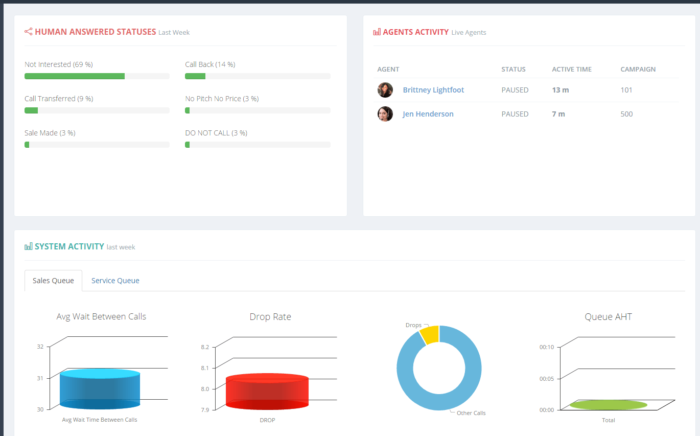
For outbound call centers, having both a good average wait time between calls for your agents and a low drop rate is vital to running an effective, efficient call center with your predictive dialer. Before we get into the causes, let’s define the terms first.
What Is Average Wait Time in an Outbound Telecalling Process – This is the average time and agent waits on the dialer between calls. Once the call is complete and has been dispositioned, the agent will be back in ready mode waiting for another call, so this is simply the average amount of time they will have to wait.
Calls Offered Vs Calls Handled – The calls offered are the calls reached queue, that will then be transferred to live agents. The calls handled are the calls that are answered from the call queue.
Dropped Call Rate % – This is the rate at which live answer calls are dropped due to no agent being available. For instance, if the dialer is dialing 15 lines at a time for 3 agents, and 4 customers answer the call at the same time, the 4th call will be dropped because there is no agent to transfer to call to. Legally, you must abide by less than a 3% drop rate over the course of any given 30 day period.
Abandon Rate Call Center: What Is an Acceptable Drop Rate – Efficient call centers have an average wait time between 15-40 seconds and a drop rate under 3%, but that’s harder to achieve with either poor or used up leads or less than 4 agents. The trick is to find the sweet spot for your outbound call center where you can maximize efficiency with your wait time and drop rate.

How to Reduce Wait Time in a Call Center: 6 Tips
Here are the things that go into play that contribute to a good wait time and drop rate.
- Number of agents logged into a campaign – the more agents available to take calls, the more efficient the dialer can be as it will be able to transfer a live call to an agent as soon as someone picks up the phone
- Quality of leads – If your leads have a low answer rate, or you get a lot of disconnected numbers and answering machines, it will take the dialer longer to find a live person to transfer to your agents.
- Dial level – The higher the dial level, the more lines the dialer calls at a time per agent. Don’t forget that a high dial level can cause an undesirable drop rate if it’s finding too many live people too quickly for your agents.
- Available Only Tally – This setting determines whether or not the dialer continues to dial lines assigned to an agent when they’re on the call. We recommend keeping it on Y in most cases, so it stops dialing when an agent is on a call otherwise the dropped call rate could increase.
- Answering Machine Detection – If AMD is turned on, agents won’t get voicemails, but it also leads to a longer wait time since they’re ONLY waiting for live calls. Although some call centers only want their agents taking live calls, we feel like leaving AMD off is best in most cases because leaving voicemails do work if done effectively and it also helps minimize the “telemarketer delay.”
- Lead Recycling or Reset List – When you are recycling leads or reset a list, it’s going to be calling back “No Answers” and “Answering Machines”, or people who you couldn’t reach the first time. When you call back those statuses again, you’re less likely to find a live person since they didn’t answer the first time which will contribute to a longer wait time.

In conclusion, many factors play a role in average wait time and dropped call rate in a predictive dialer. The most important are the number of agents in a campaign, the speed of the dialer, and the quality of the leads. Ensure your call center is efficient with a world-class predictive dialer!

